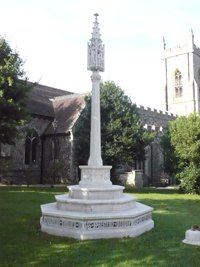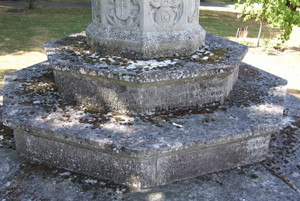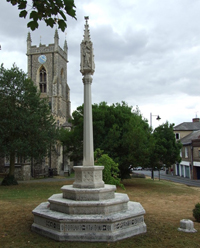Showcase result
Halstead
Town or City: Halstead
County: Essex
Country: England
WMT Reference Number: WM2243
Value of grant: £900.00
Type of memorial: Freestanding
Type of work: Conservation and repair
Grant scheme: WMT Grant Scheme
Year: 2018
UKNIWM reference number: 22226
 The memorial in St. Andrew’s Churchyard, Halstead, Essex is free-standing lantern cross with a steeple roof. The shaft of the cross is stands on an octagonal plinth, which is itself on an octagonal three-stepped base. It is made from Portland stone and the base of the memorial is Portland stone with flint panels. The vertical faces of the bottom step have an inscription, and the vertical faces of the two other steps are inscribed with the names of those who died in the wars. There are carvings round the vertical faces of the plinth.
The memorial in St. Andrew’s Churchyard, Halstead, Essex is free-standing lantern cross with a steeple roof. The shaft of the cross is stands on an octagonal plinth, which is itself on an octagonal three-stepped base. It is made from Portland stone and the base of the memorial is Portland stone with flint panels. The vertical faces of the bottom step have an inscription, and the vertical faces of the two other steps are inscribed with the names of those who died in the wars. There are carvings round the vertical faces of the plinth.
In December 2007 War Memorials Trust offered a grant of £880 towards work to treat the memorial with masonry biocide; clean the entire memorial by using of water or steam cleaning or isolated poultice cleaning; to point up with lime mortar areas of minor cracking to joints; to re-point failing or loose joints; and to check over the flint panels and replace any loose or missing flints. The work to renovate the memorial was completed in May 2008.
 In 2018, a further grant from War Memorials Trust Grants Scheme, supported by the First World War Memorials Programme, helped repair and conservation works. This included steam cleaning and re-pointing. As the memorial is within a churchyard a Faculty was required to enable works to take place.
In 2018, a further grant from War Memorials Trust Grants Scheme, supported by the First World War Memorials Programme, helped repair and conservation works. This included steam cleaning and re-pointing. As the memorial is within a churchyard a Faculty was required to enable works to take place.
The memorial cross was given in 1920 by Mrs. Edian Courtauld as a thanksgiving for the safe return of her brothers from the Great War, and in memory of those from Halstead who did not return. The Courtaulds were a textile manufacturing family and generous benefactors of Halstead and the surrounding area, building village halls, homes of rest and houses. Three generations of the family, including Edian Courtauld’s husband Samuel Augustine Courtauld, who from 1916 lived at the Howe, were High Sheriffs of Essex. Samuel Augustine’s cousin, also called Samuel, endowed the Courtauld Institute of Art in London, and that Samuel’s brother, Stephen, rebuilt Eltham Palace as an Art Deco masterpiece.
 The memorial was designed by Mr. F. Howard of Oxford after the model of an original fourteenth century cross in Cricklade, Wiltshire, with local details, for example the shaft is a replica of the shaft of the partly-destroyed cross at Lavenham.
The memorial was designed by Mr. F. Howard of Oxford after the model of an original fourteenth century cross in Cricklade, Wiltshire, with local details, for example the shaft is a replica of the shaft of the partly-destroyed cross at Lavenham.
The cross was dedicated on 8th May 1920 by Dr. Whitcombe, bishop of Colchester, and unveiled by Lord Byng of Vimy. Julian Byng had been an officer in the regular army and served with distinction during World War I with the British Expeditionary Force in France, in the Battle of Gallipoli of the Dardanelles campaign and as commander of the Canadian Corps. He succeeded Sir Edmund Allenby as commander of the British Third Army. His most celebrated action with the Canadian victory at the Battle of Vimy Ridge in April 1917, and he was created 1st Baron Byng of Vimy and Thorpe-le-Soken in 1919. Lord Byng and his wife had bought a house in Essex in 1909, and apart from six and a half years spent as Governor General in Canada, he lived in the county until he died in 1935.
Further information
War Memorials Trust reference WM2243
UK National Inventory of War Memorials: 22226
War Memorials Online: 101868
Photographs of Dr. Whitcombe (1862 – 1922), the Bishop of Colchester, who dedicated the memorial
http://www.flickr.com/photos/14248654@N04/
For more information about Lord Byng of Vimy (1862 – 1935) who unveiled the memorial
http://en.wikipedia.org/wiki/Julian_Byng
If you have a concern about this memorial please contact the Trust on conservation@warmemorials.org


